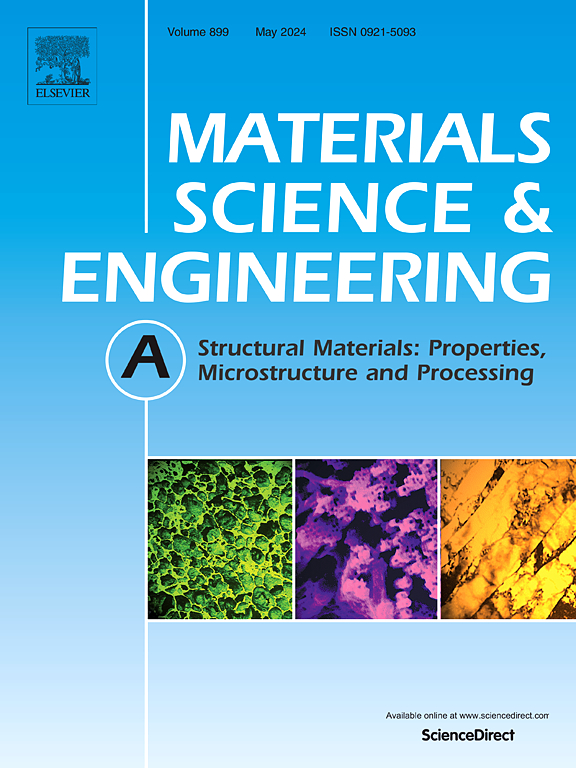高级高强度钢在宽淬火温度下的多阶段微观组织演变和机械响应:马氏体/贝氏体碳分配的协同设计
IF 7
2区 材料科学
Q1 MATERIALS SCIENCE, MULTIDISCIPLINARY
引用次数: 0
摘要
本研究系统地研究了高级高强度钢(AHSS)在宽淬火温度(25-400°C)范围内马氏体和贝氏体碳分配机制之间的协同相互作用。可以发现,等温保温过程中的贝氏体转变动力学受QT控制,表现出与组成相缺陷密度相关的三个阶段相关的加速。残留的奥氏体(RA)组分遵循依赖于温度的碳分配机制:在低温度(≤100℃)下,有限的RA(≤3 vol%)仅由马氏体碳分配引起,而中等温度(150-200℃)使马氏体和贝氏体碳分配协同作用,其中马氏体机制主导了RA含量的快速增加(高达12 vol%)。高QTs(≥225°C)通过受t0线限制的贝氏体碳分配稳定RA (~ 12 vol%)。此外,通过整合t0线或WBs理论,开发了一个改进的约束碳平衡模型,以纳入贝氏体的形成,从而能够在整个QT范围(25-400°C)内高精度预测奥氏体保留。力学响应也表现出三个阶段的QT依赖性,由RA和主导相的特征决定:在m1主导的微结构中,具有超高强度和低延展性(QT≤100°C);在中间QTs(150-200°C)中具有优异的强度-塑性组合(UTS ~ 1100mpa, TEL ~ 22%),显微组织包含RA(≤12.1%)和少量贝氏体;在贝氏体占主导地位(QT≥225°C)中稳定(UTS ~ 1000 MPa, TEL ~ 22%)。在≥275°C的QTs中,这种卓越的显微结构和机械一致性为工业AHSS生产提供了无与伦比的工艺灵活性,消除了严格的热控制要求。本文章由计算机程序翻译,如有差异,请以英文原文为准。
Tailoring multi-stage microstructural evolution and mechanical responses in advanced high-strength steels across wide quenching Temperatures: Synergistic design of martensitic/bainitic carbon partitioning
This study systematically investigates the synergistic interplay between martensitic and bainitic carbon partitioning mechanisms in advanced high-strength steels (AHSS) across a broad quenching temperature (QT) range (25–400 °C). It can be found that the bainite transformation kinetics during isothermal holding are governed by QT, showing three stage-dependent acceleration linked to defect density of constituent phases. The retained austenite (RA) fractions follow QT-dependent carbon partitioning mechanisms: limited RA (≤3 vol%) arises solely from martensitic carbon partitioning at low QTs (≤100 °C), while intermediate QTs (150–200 °C) enable synergy between martensitic and bainitic carbon partitioning, with the dominant martensitic mechanism driving a rapid increase in RA content (up to ∼12 vol%). High QTs (≥225 °C) stabilize RA (∼12 vol%) via bainitic carbon partitioning constrained by the T0-line limit. In addition, a modified constrained carbon equilibrium model was developed by integrating T0-line or WBs theory to incorporate bainite formation, enabling high-precision prediction of austenite retention across the full QT range (25–400 °C). The mechanical responses also exhibit three-stage QT dependence, dictated by the characteristics of RA and dominant phase: ultrahigh strength with low ductility in M1-dominated microstructures (QT ≤ 100 °C); excellent strength-ductility combination (UTS ∼1100 MPa, TEL ∼22 %) in intermediate QTs (150–200 °C) with microstructures incorporated RA (≤12.1 vol%) and minor bainite; and stabilize (UTS ∼1000 MPa, TEL ∼22 %) in bainite-dominated regimes (QT ≥ 225 °C) with stable phase fractions. This remarkable microstructural and mechanical consistency across QTs ≥275 °C provides unparalleled process flexibility for industrial AHSS production, eliminating stringent thermal control requirements.
求助全文
通过发布文献求助,成功后即可免费获取论文全文。
去求助
来源期刊

Materials Science and Engineering: A
工程技术-材料科学:综合
CiteScore
11.50
自引率
15.60%
发文量
1811
审稿时长
31 days
期刊介绍:
Materials Science and Engineering A provides an international medium for the publication of theoretical and experimental studies related to the load-bearing capacity of materials as influenced by their basic properties, processing history, microstructure and operating environment. Appropriate submissions to Materials Science and Engineering A should include scientific and/or engineering factors which affect the microstructure - strength relationships of materials and report the changes to mechanical behavior.
 求助内容:
求助内容: 应助结果提醒方式:
应助结果提醒方式:


